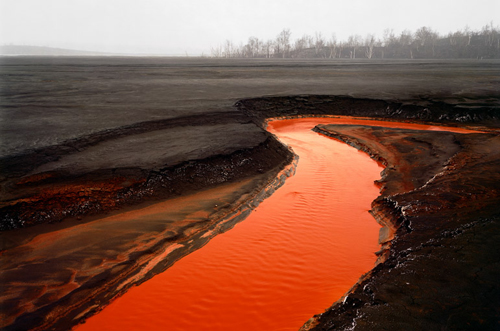 Thjorsá River #1Iceland, 2012, copyright Edward Burtynsky
Thjorsá River #1Iceland, 2012, copyright Edward Burtynsky
“We took what we needed from the Earth and this is what we left behind. That is the informational layer of my work, but there is also a political layer and an autobiographical one.”
Edward Burtynsky (1955 – present) is still very much alive and working today. One of Canada’s most respected photographers, his large-format photographs of industrial landscapes and man’s impact on the land are stunning. I spent time at an exhibit of his this summer in Vancouver, and was deeply moved by his sweeping views of landscapes altered by industry: hauting images of quarries in Italy, mine tailings in Canada, and shipbreaking in Bangladesh, among others. His work shows an awareness of scale and pattern, and an awesome juxtaposition of beauty and man’s terrible impact. It’s easy to see his early influences, too, like Ansel Adams, and Edward Weston.
Like all of us, Burtynsky is a product of his upbringing, and it’s no surprise that a man who grew up in industrial St. Catharines, Ontario, with a father who worked in automotive manufacturing, also ended up working in both mining and automotive assembly lines, before going to art school. Edward’s father, in daily contact with PCBs, died from cancer at 45, Edward was only 15 at the time. Knowing this gives a depth to Burtynsky’s work and makes it more human. More than a study in lines and clever use a scale, these are often painful photographs that demand a response from the reader. His large format work shows incredible detail and while I highly recommend you look at his work online and in books, if you have a chance to see Burtynsky exhibited, do so. As someone who loves landscape photography, and has more than a passing interest in photography as a means of expression and social change, Burtynsky is deeply inspiring.
 Nickel Tailings #34Sudbury, Ontario 1996. Copyright Edward Burtynsky
Nickel Tailings #34Sudbury, Ontario 1996. Copyright Edward Burtynsky
 Rock of Ages #7Active Section, E.L. Smith Quarry, Barre, Vermont, USA, 1991
Rock of Ages #7Active Section, E.L. Smith Quarry, Barre, Vermont, USA, 1991
Copyright Edward Burtynsky
“Residual landscapes tell us something important. We take what we want, then leave the residue of our taking. Once we take what we value, the voids that remain are very revealing.”
There’s a great video here (almost 7 minutes), from the Vancouver Art Gallery, and longer documentaries here:
Manufactured Landscapes, by Jennifer Baichwal
Watermark, co-directed by Jennifer Baichwal and Edward Burtynsky
Here are two gorgeous books of his work, the first among my favourites – Manufactured Landscapes, (Amazon Link), and Quarries (Amazon link) Highly recommended!

Comments
Wow, I check out the links and after looking at the images…it looks like I have a destination shoot over the horizon. Thank you for getting my creative juices flowing.
George.
The nickel tailings photo makes me want to cry. A real punch in the gut.